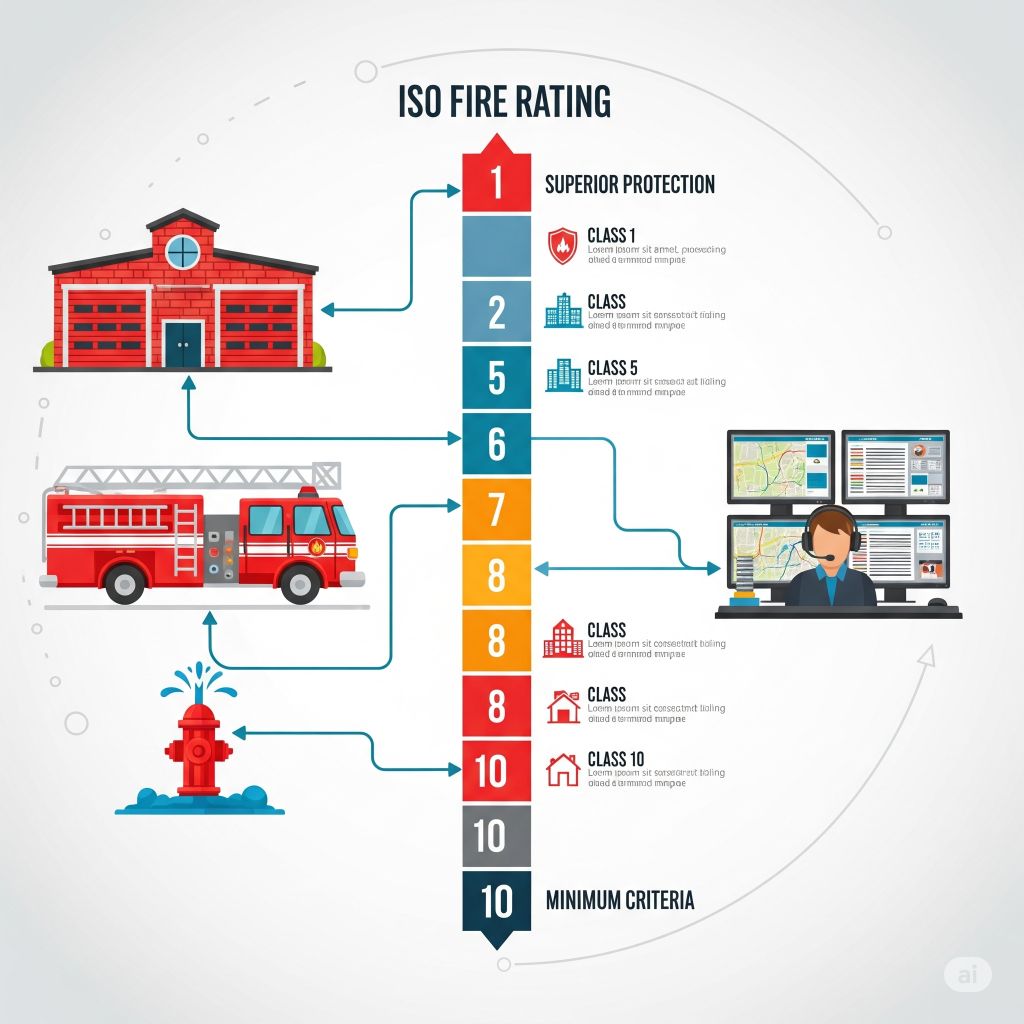
As someone who is always on the lookout for ways to protect my business and assets, understanding ISO ratings has been crucial. It’s not just a random number – it holds significant importance in the world of insurance and risk management.
When I first delved into the realm of ISO ratings, I was amazed by how much they can impact insurance premiums, emergency response, and overall safety measures. Knowing your ISO rating can make a world of difference in terms of preparedness and financial security.
In this article, I’ll break down what an ISO rating is, why it matters, and how it can directly affect you and your business. Stay tuned to uncover the key insights that will empower you to make informed decisions and safeguard what matters most.
Key Takeaways
- ISO ratings are Public Protection Classifications that assess a community’s fire protection capabilities, impacting insurance premiums, emergency response, and financial security.
- Lower ISO ratings indicate superior fire protection, leading to reduced insurance costs for property owners and improved safety measures.
- Improved ISO ratings result in lower insurance premiums as insurers view areas with better ratings as less risky, translating to significant savings annually.
- ISO ratings play a vital role in emergency response by determining response times and safety measures, emphasizing the importance of investing in fire protection measures.
- Businesses can benefit from lower insurance premiums and enhanced fire protection resources with better ISO ratings, leading to cost savings and improved safety for employees and customers through proactive fire safety measures.
Understanding ISO Rating
When it comes to ISO ratings, it’s crucial to have a clear understanding of what they entail. An ISO rating is a Public Protection Classification (PPC) given to a community after evaluating its fire protection capabilities. This evaluation by the Insurance Services Office (ISO) assesses various factors like fire department efficiency, water supply, and emergency communications systems.
In simpler terms, ISO ratings help insurance companies determine the level of risk associated with insuring a property in a specific area. Communities with better ISO ratings tend to have lower insurance premiums, as they are deemed to have superior fire protection services, leading to reduced risks for insurers.
As an individual or business owner, knowing your ISO rating can provide valuable insights into your property’s safety levels and potential insurance costs. By understanding your ISO rating, you can take proactive steps to improve fire safety measures, potentially leading to a better rating and lower insurance premiums.
In essence, ISO ratings are not just random numbers; they are a reflection of the overall fire protection capabilities of a community, impacting insurance premiums, emergency response times, and ultimately, your financial security.
Importance of ISO Rating
When it comes to understanding the significance of an ISO rating, lower ISO ratings signify superior fire protection capabilities in a community. This directly affects insurance premiums, with lower ratings translating into lower costs for property owners.
As an individual or business owner, being aware of your ISO rating can provide valuable insights into the level of safety and security in your area. It’s crucial to recognize that ISO ratings impact not just insurance expenses but also emergency response times and overall financial well-being.
Improving your community’s ISO rating involves enhancing fire protection measures, which in turn can lead to substantial cost savings. By investing in better fire safety infrastructure and services, communities can elevate their ISO ratings and enjoy the associated benefits of lower insurance premiums and enhanced fire protection services.
Impact on Insurance Premiums
Lower ISO ratings have a direct impact on insurance premiums, with better fire protection leading to reduced costs for property owners. Improved ISO ratings indicate enhanced safety measures, resulting in lower risks of fire damage. This translates to lower insurance premiums as insurance companies view areas with lower ISO ratings as less risky. As a homeowner, a lower ISO rating can mean significant savings on insurance costs annually.
Insurance companies use ISO ratings to assess the level of risk associated with providing coverage in a specific area. A low ISO rating signifies that the community has adequate fire protection, reducing the likelihood and severity of fire-related incidents. Consequently, individuals residing in areas with favorable ISO ratings may benefit from discounted insurance rates compared to those in areas with higher ratings.
By understanding how ISO ratings influence insurance premiums, homeowners can make informed decisions about their coverage options. Investing in improving fire protection measures can not only enhance safety but also lead to substantial savings on insurance premiums in the long run. Insurers often reward communities with proactive fire safety initiatives by offering lower insurance costs, making it a worthwhile investment for homeowners to prioritize fire protection measures.
Statistics: ISO Ratings and Insurance Premiums
| ISO Rating | Average Insurance Premium Reduction (%) |
|---|---|
| 1 | 60 |
| 2 | 40 |
| 3 | 25 |
| 4 | 15 |
| 5 | 10 |
Role in Emergency Response and Safety Measures
In emergency situations, ISO ratings play a crucial role in determining the effectiveness of response times and safety measures. A lower ISO rating indicates that a community has better equipment, training, and resources to handle fires, ultimately leading to quicker emergency responses.
With an improved ISO rating, fire departments are better equipped to protect lives and property, as they have access to advanced technologies and adequate staffing. This not only enhances overall safety within the community but also reduces the risk of extensive property damage in the event of a fire.
Investing in fire protection measures to improve an area’s ISO rating can have a significant impact on the overall safety and well-being of residents. By prioritizing safety and emergency preparedness, communities can mitigate risks and ensure a more efficient response to fire incidents.
How ISO Rating Affects You and Your Business
Ensuring a favorable ISO rating isn’t just about meeting standards; it directly impacts insurance costs and emergency response in your community. When ISO ratings improve, businesses often see a reduction in insurance premiums. As a business owner, a lower ISO rating can translate to significant cost savings over time.
Additionally, a better ISO rating means that your community has enhanced fire protection resources. This can lead to quicker emergency responses in case of a fire, helping to minimize property damage. As a result, not only is your business better protected, but your employees and customers are as well.
Investing in fire protection measures to improve your ISO rating isn’t just about financial benefits. It’s about safeguarding lives and protecting your assets. By taking proactive steps to enhance your fire protection infrastructure, you’re contributing to a safer environment for everyone in your community.
It’s crucial for businesses to understand the direct impact that ISO ratings can have on their operations. By prioritizing fire safety and emergency preparedness, you’re not only ensuring compliance but also strengthening the resilience of your business against unforeseen events.
Conclusion
Understanding ISO ratings is key to managing insurance costs and enhancing emergency response efforts. By improving ISO ratings, businesses can enjoy lower insurance premiums and faster assistance during fire incidents. Prioritizing fire protection not only saves money but also protects lives and assets. It’s essential for businesses to invest in fire safety measures to increase their resilience and contribute to a safer community overall.
Frequently Asked Questions
What is an ISO rating and why does it matter for insurance costs?
An ISO rating is a measure of a community’s fire protection capabilities. It influences insurance costs by assessing the risk of property damage due to fires. Communities with higher ISO ratings may face higher insurance premiums, while lower ratings can lead to cost savings for businesses and homeowners.
How can improving ISO ratings benefit businesses?
Improving ISO ratings can result in reduced insurance premiums for businesses, making it a cost-effective investment. Lower ratings can attract lower insurance costs, making businesses more financially stable and competitive in the long run.
Why is a quick emergency response important in relation to ISO ratings?
A quick emergency response, facilitated by a good ISO rating, can help minimize property damage during fires. Quicker response times can also save lives, protect assets, and reduce the overall impact of fires on the community.
How can prioritizing fire protection measures impact communities?
Prioritizing fire protection measures not only leads to financial benefits but also enhances the safety and well-being of communities. Stronger fire protection measures can safeguard lives, assets, and the environment, creating a more resilient and secure community for everyone.
Why is it crucial for businesses to focus on fire safety and emergency preparedness?
Focusing on fire safety and emergency preparedness is crucial for businesses to strengthen their resilience against unexpected incidents. By investing in these measures, businesses can protect their assets, ensure employee safety, and contribute to creating a safer environment for the entire community.
